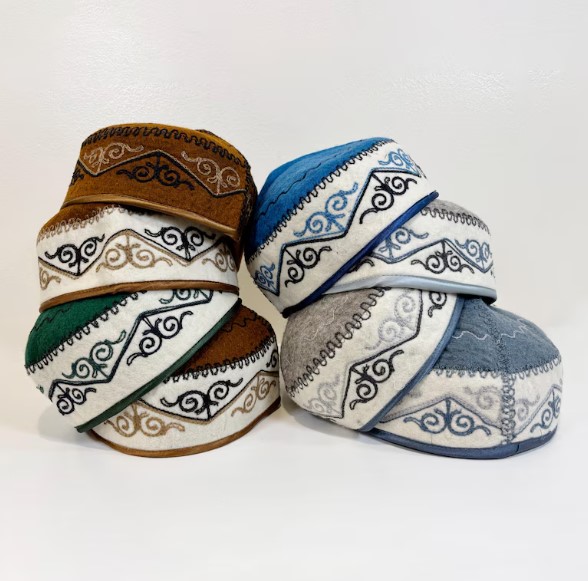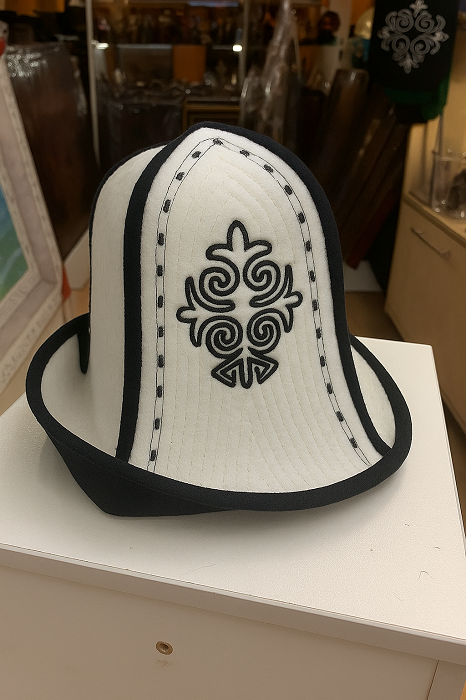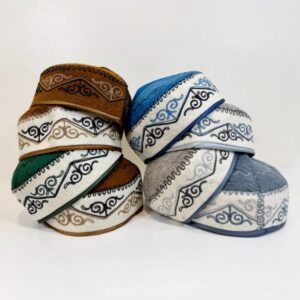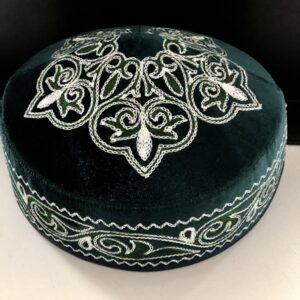100% Authentic Kyrgyz Ak Kalpak Hat
$29.00
This distinctive white felt hat has transcended its practical origins to become a powerful symbol of Kyrgyz identity, craftsmanship, and cultural continuity.
The Kyrgyz Kalpak stands as one of Central Asia’s most recognizable and culturally significant traditional headwear pieces. This distinctive white felt hat has transcended its practical origins to become a powerful symbol of Kyrgyz identity, craftsmanship, and cultural continuity. Whether you’re interested in traditional crafts, Central Asian culture, or unique fashion accessories, understanding the Kalpak offers fascinating insights into Kyrgyz heritage.
What is a Kyrgyz Kalpak?
The Kalpak (also spelled “kalpok” or “kalpac”) is a traditional conical felt hat worn primarily by Kyrgyz men. Characterized by its distinctive white color and four-paneled construction, this handcrafted headpiece features intricate geometric patterns and symbolic designs that carry deep cultural meaning. The hat’s unique shape and decorative elements make it instantly recognizable as a symbol of Kyrgyz culture.
Key Characteristics of the Traditional Kalpak
- Material: Made from high-quality white felt, typically from sheep’s wool
- Shape: Conical design with four triangular panels
- Color: Predominantly white, symbolizing purity and wisdom
- Decoration: Features traditional Kyrgyz ornamental patterns
- Construction: Hand-sewn using traditional techniques passed down through generations
Historical Origins and Cultural Significance
Ancient Roots in Nomadic Culture
The Kalpak’s history stretches back centuries to the nomadic lifestyle of the Kyrgyz people. Originally designed for practical purposes, the hat provided essential protection against the harsh mountain climate of the Tian Shan region. The thick felt material offered insulation against cold winds, while the distinctive shape helped shed rain and snow.
Archaeological evidence suggests that similar felt hats were worn by Central Asian nomads as early as the 5th century BCE, making the Kalpak part of an ancient tradition of felt-working expertise that defines the region’s cultural identity.
Symbolism and Meaning
Every aspect of the Kalpak carries symbolic weight in Kyrgyz culture:
The Four Panels: Represent the four elements, the four seasons, or the four cardinal directions, reflecting the nomadic understanding of natural harmony.
White Color: Symbolizes purity, wisdom, and the snow-capped peaks of the Kyrgyz mountains.
Geometric Patterns: Traditional designs often include ram’s horns, representing strength and prosperity, and other motifs connected to nomadic life and nature worship.
Traditional Kalpak Making Process
Creating an authentic Kyrgyz Kalpak requires considerable skill and traditional knowledge. Master craftsmen, known as “kalpakchi,” spend years perfecting their techniques:
- Wool Preparation: High-quality sheep’s wool is cleaned, combed, and prepared for felting
- Felting Process: Wool is layered, moistened, and repeatedly pressed and rolled to create dense felt
- Shaping: The felt is carefully molded into the distinctive conical shape
- Pattern Creation: Traditional designs are applied using specialized techniques
- Final Assembly: The four panels are expertly sewn together with precise stitching
Regional Variations
Different regions of Kyrgyzstan have developed their own Kalpak variations, each with unique decorative elements and slight structural differences. Northern Kyrgyz Kalpaks often feature more elaborate embroidery, while southern versions may incorporate different color accents or pattern arrangements.
Reviews
There are no reviews yet.





Be the first to review “100% Authentic Kyrgyz Ak Kalpak Hat”